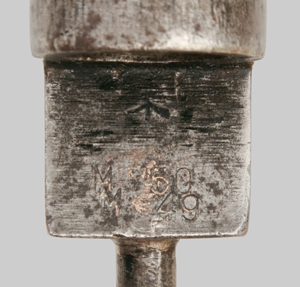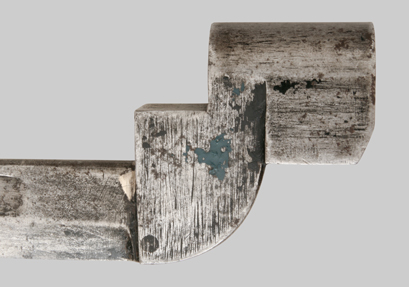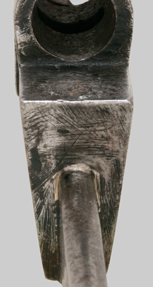The No. 9 Mk. I bayonet has an interesting history. It represents the culmination of a post-war desire to replace the
No. 4 spike bayonet. The first attempt to do so resulted in the innovative
No. 7 Mk. I/L bayonet. With the War Department's decision not to issue the No. 7 Mk. I/L bayonet with the
.303 caliber Lee-Enfield No. 4 rifle, there remained a strong desire to replace the No. 4 spike bayonet. Compared to the elaborate No. 7 Mk. I/L, he No. 9 Mk. I was a much simpler, utilitarian affair, with a sturdy socket pinned to the clip-point blade of
the No. 5 Mk. I bayonet. Because the No. 9 Mk. I blade was closely patterned on the No. 5 Mk. I bayonet, the
No. 5 scabbard was retained for use with the No. 9 Mk. I bayonet. Production commenced in 1947, even before the No. 9 Mk. I was officially approved. (They couldn't off the No. 4 Spike soon enough!). Indigenous versions of the No. 9 bayonet were also produced in Pakistan and South Africa.
Britain—Royal Ordnance Factory, Poole

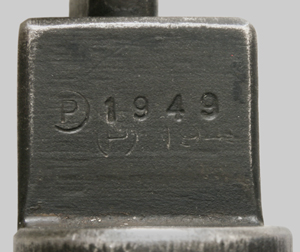
Approximately 200,000 No. 9 Mk. I bayonets were produced at the Royal Ordinance Factory, Poole, from 1947–1949. The Poole bayonets are the earliest documented production of the No. 9 Mk. I bayonet. Poole's maker mark is a letter "P" inside a circle, followed by the year of manufacture. The example pictured was made at ROF Poole in 1949.
Britain—Royal Small Arms Factory, Enfield
Production was transferred to the Royal Small Arms Factory, Enfield in 1949. 366,902 No. 9 Mk. I bayonets were made at RSAF Enfield between 1949–1956, with an additional 10,000 produced in 1962. The Enfield maker mark is a superimposed "ED", followed by a two-digit year of manufacture. The bayonet pictured below was made at RSAF Enfield in 1954.

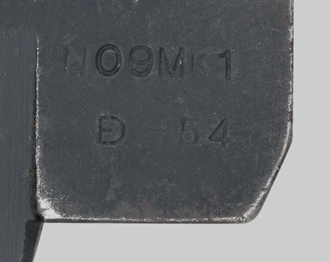
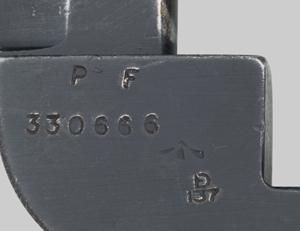
The "PF" serialized No. 9 Mk. I bayonets were packed with post-war Lee-Enfield No. 4 rifles produced at the ROF Fazakerly for export to foreign countries. The PF number corresponds to the rifle's serial number. This example's serial number is part of the Irish Contract for No. 4 Mk. II rifles that was never delivered.
Britain—Private Contractors
In addition to ROF Poole and RSAF Enfield, three private firms are believed to have manufactured small quantities of the No. 9 Mk. I bayonet. The bayonets are marked on the ledge, with the maker's dispersal code and the broad arrow. Some have a single letter on the blade, near the socket join (viewer's mark?). The makers are believed to be:
• G. Buggins & Co. Ltd. of Redditch.
• Francis & Barnett Ltd. of Coventry.
• Byfords Ltd. of West Bromwitch.
Little is known of this production. The use of dispersal codes suggests manufacture likely occurred early in the post-war period, perhaps even prior to production commencing at ROF Poole. However, this is speculation, as no documentation of this production exists.
Francis & Barnett Ltd

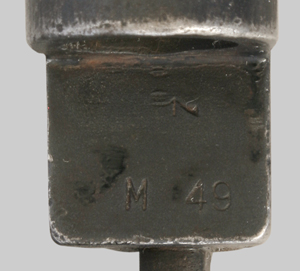
The bayonet pictured was made by Francis & Barnett Ltd. The finish quality is not up to the standard of the government factories. Francis & Barnett manufactured motorcycles that were affectionately known as the "Fanny-B". These bayonets were very rare, with only a handful of known examples. However, they began turning up with some regularity, beginning in 2011. Still a scarce bayonet.
Byfords Ltd.

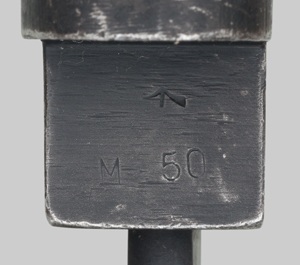
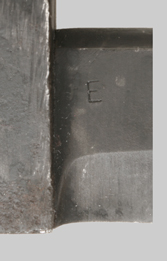
The bayonet pictured was made by Byfords Ltd. The quality and finish is poor, not nearly as good as the Francis & Barnett bayonet pictured above. Almost nothing is known about Byfords. Only a few examples are known.
The British No. 9 Bayonet & Foreign Copies
|
|
 |
|
|
|
|
|
|
|
|
|
|
|
|
|
|
|
|
|
|
|
Bayonet
Collectors'
Network |
|
 |
|
| Society of American Bayonet Collectors |
|
|
|
|
|
| |
|
| |
|
| |
|
| |
|
| |
|
| |
|
| |
|
| |
|
| |
|
| |
|
| |
|
| |
|
| |
|
| |
|
| |
|
| |
|
| |
|
| |
|
| |
|
| |
|
| |
|
| |
|
| |
|
| |
|
| |
|
| |
|
| |
|
| |
|
| |
|
| |
|
| |
|
| |
|
| |
|
| |
|
| |
|
| |
|
| |
|
| |
|
| |
|
| |
|
| |
|
| |
|
| |
|
| |
|
| |
|
| |
|
| |
|
| |
|
| |
|
| |
|
| |
|
| |
|
| |
|
| |
|
| |
|
| |
|
| |
|
| |
|
| |
|
| |
|
| |
|
| |
|
| |
|
| |
|
| |
|
| |
|
| |
|
| |
|
| |
|
| |
|
| |
|
| |
|
| |
|
| |
|
| |
|
| |
|
| |
|
| |
|
| |
|
| |
|
| |
|
| |
|
| |
|
| |
|
| |
|
| |
|
| |
|
| |
|
| |
|
| |
|
| |
|
| |
|
| |
|
| |
|
| |
|
| |
|
| |
|
| |
|
| |
|
| |
|
| |
|
| |
|
| |
|
| |
|
| |
|
| |
|
| |
|
| |
|
| |
|
| |
|
| |
|
| |
|
| |
|
| |
|
| |
|
| |
|
| |
|
| |
|
| |
|
| |
|
| |
|
| |
|
| |
|
| |
|
| |
|
| |
|
| |
|
| |
|
| |
|
| |
|
| |
|
| |
|
| |
|
| |
|
| |
|
| |
|
| |
|
| |
|
| |
|
| |
|
| |
|
| |
|
| |
|
| |
|
| |
|
| |
|
| |
|
| |
|
| |
|
| |
|
| |
|
| |
|
| |
|
| |
|
| |
|
| |
|
| |
|
| |
|
| |
|
| |
|
| |
|











